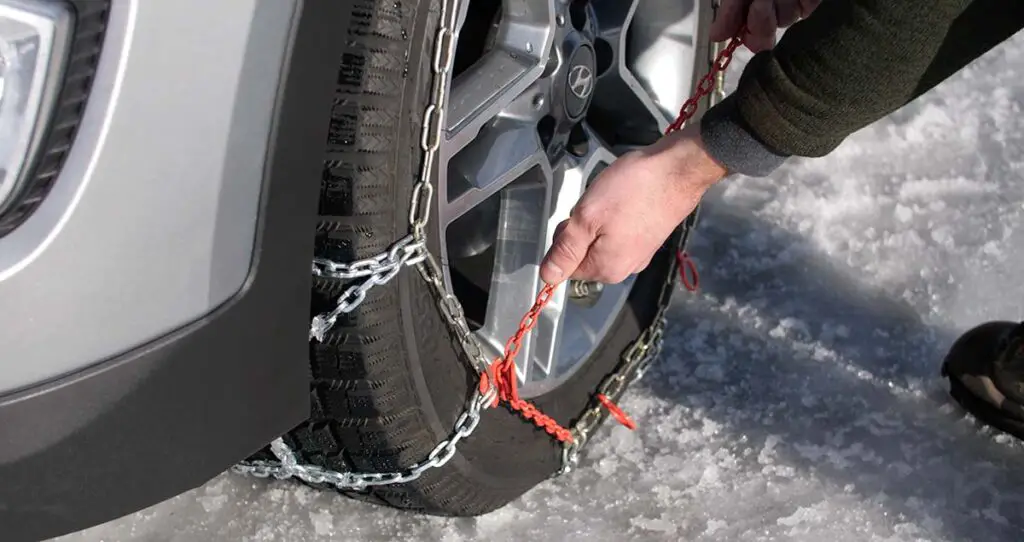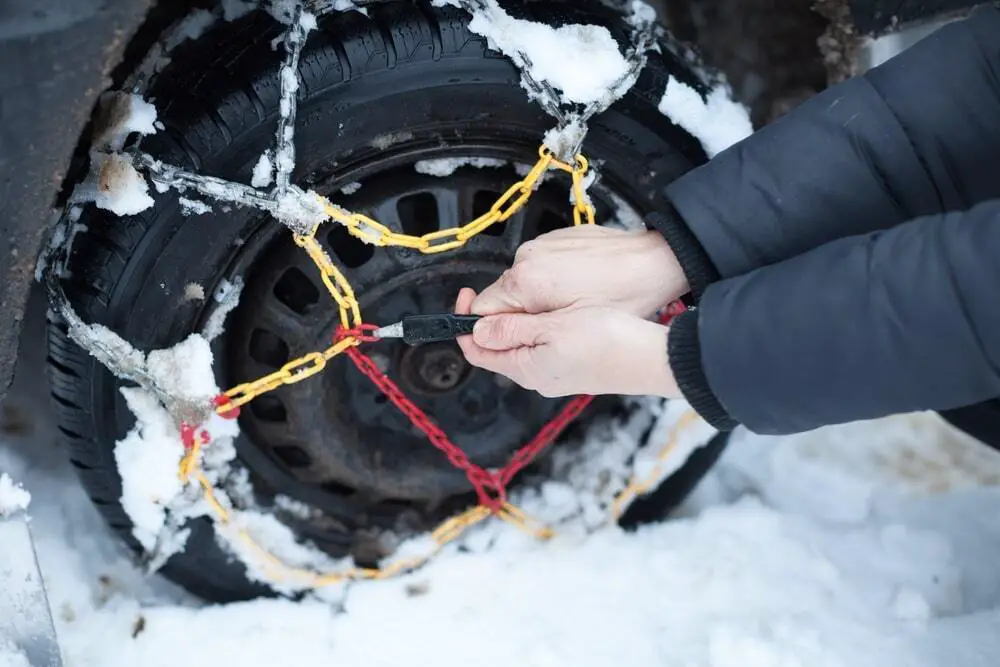To put on snow chains, lay them flat, drape them over the tires, and secure the fasteners. Ensure they are snug and evenly distributed, then test by driving a short distance. Adjust as needed for a proper fit.
Driving in snowy and icy conditions can be challenging and dangerous without the right equipment. Snow chains, also known as tire chains, are an essential tool for providing the necessary traction to navigate these treacherous roads safely.
In this comprehensive guide, we’ll walk you through the process of installing snow chains on the vehicle, ensuring you’re prepared for winter driving conditions.

Contents
Why Use Snow Chains?
Snow chains offer several benefits:
- Increased Traction: They provide better grip on snow and ice, reducing the risk of skidding.
- Improved Safety: Enhanced traction leads to safer driving in adverse weather conditions.
- Legal Requirements: In some regions, snow chains are mandatory during winter months or in specific areas.
- Versatility: Suitable for a variety of vehicles, including cars, SUVs, and trucks.
Choosing the Right Snow Chains
Before diving into the installation process, it’s crucial to select the appropriate snow chains for your vehicle:
- Check Your Owner’s Manual: Ensure your vehicle can accommodate snow chains. Some vehicles have limited wheel well clearance.
- Know the Tire Size: Find the size on the tire’s sidewall (e.g., P215/65R15).
- Select the Right Type: There are various types of chains, including cable chains, link chains, and hybrid models. Choose one that fits your driving needs and vehicle.
Preparing for Installation
Having the right tools and a clear understanding of the process is essential for a smooth installation experience.
Tools and Materials Needed:
- Snow chains
- Gloves (to protect your hands from the cold and sharp edges)
- Towel or mat (to kneel on)
- Flashlight (if installing in low light conditions)
Step-by-Step Installation Guide for How to Put on Snow Chains
Follow these detailed instructions to ensure your snow chains are correctly and safely installed.
Practice Installation: Before hitting the road, practice installing the chains in a dry, safe environment like your garage or driveway.
Park Safely: Find a safe, level spot away from traffic. Turn off the engine, engage the parking brake, and ensure your vehicle is in park.
Lay Out the Chains: Remove the chains from their storage bag and untangle them. Lay them flat on the ground, ensuring there are no twists or knots.
Position the Chains: Drape the chains over the top of the tire, ensuring the smooth side of the cross-links faces outward. Align the chains so they are evenly distributed over the tire.
Connect the Inside Fastener: Reach behind the tire and connect the inner fastener. This might be a hook, clasp, or chain link, depending on your chain type.
Pull the Chains Tight: Pull the chains around the front of the tire and connect the outside fastener. Ensure the chains are snug but not overly tight.
Adjust and Secure: Adjust the chains so they are evenly spaced and secure around the tire. Use tensioners or bungee cords if provided to maintain tension and prevent the chains from loosening.
Repeat for Remaining Tires: If required, repeat the process for the other tires. Typically, chains are installed on the drive wheels, but consult your vehicle’s manual for specific instructions.
Test the Chains: Drive a short distance (a few feet) and then stop to check the chains. Ensure they remain tight and properly aligned.
Driving with Snow Chains
Driving with snow chains requires careful attention to speed and road conditions to ensure safety and prevent damage.
- Reduced Speed: Drive slowly, typically no more than 30 mph (50 km/h), to prevent damage to the chains and your tires.
- Smooth Driving: Avoid sudden acceleration, hard braking, and sharp turns.
- Listen and Feel: Pay attention to unusual noises or vibrations, which may indicate loose or improperly installed chains.
Removing Snow Chains
Removing snow chains properly ensures they are ready for future use and prevents damage to the vehicle.
- Find a Safe Spot: Park safely away from traffic.
- Disengage Fasteners: Disconnect the outside and inside fasteners.
- Remove Chains: Carefully pull the chains off the tires and lay them flat.
- Store Properly: Clean and dry the chains before storing them in their bag to prevent rust and tangling.

Maintenance Tips
Proper maintenance of your snow chains is crucial to ensure their longevity and effectiveness.
- Regular Inspections: Check your chains for damage, rust, or wear before each use.
- Proper Storage: Keep the chains clean, dry, and stored in a cool, dry place.
- Replacement: Replace any damaged or worn chains promptly to ensure safety and effectiveness.
Frequently Asked Questions
Here are some FAQs about how to put on snow chains –
1. Do I need snow chains on all four tires?
Typically, chains are installed on the drive wheels. However, for all-wheel drive vehicles, chains on all four tires may be recommended for optimal traction.
2. Can I drive on dry pavement with snow chains?
Driving on dry pavement with snow chains can cause damage to the chains and your tires. Remove the chains when you encounter clear roads.
3. Are snow chains legal everywhere?
Snow chain regulations vary by region. Some areas mandate their use in winter, while others may prohibit them to prevent road damage. Check local laws before traveling.
4. What should I do if a chain breaks while driving?
Stop immediately in a safe location and remove the broken chain to prevent damage to your vehicle. Replace the chain before continuing your journey.
5. How do I know if my snow chains are properly installed?
Properly installed chains should be snug, evenly distributed, and securely fastened. Test the chains by driving a short distance and checking for tightness and alignment.
Conclusion
Installing snow chains may seem daunting at first, but with practice and preparation, it becomes a straightforward task. Proper installation and maintenance of snow chains are crucial for safe winter driving, providing the traction needed to navigate snowy and icy roads confidently. By following this guide, you’ll be well-equipped to handle winter conditions and ensure your safety on the road.